SLLS362G SEPTEMBER 1999 – January 2016 SN65LVDS387 , SN65LVDS389 , SN65LVDS391 , SN75LVDS387 , SN75LVDS389 , SN75LVDS391
PRODUCTION DATA.
- 1 Features
- 2 Applications
- 3 Description
- 4 Revision History
- 5 Description (Continued)
- 6 Device Options
- 7 Pin Configuration and Functions
- 8 Specifications
- 9 Parameter Measurement Information
- 10Detailed Description
- 11Application and Implementation
- 12Power Supply Recommendations
- 13Layout
- 14Device and Documentation Support
- 15Mechanical, Packaging, and Orderable Information
パッケージ・オプション
デバイスごとのパッケージ図は、PDF版データシートをご参照ください。
メカニカル・データ(パッケージ|ピン)
- DGG|64
サーマルパッド・メカニカル・データ
発注情報
8 Specifications
8.1 Absolute Maximum Ratings
over operating free-air temperature range (unless otherwise noted)(1)| MIN | MAX | UNIT | ||
|---|---|---|---|---|
| Supply voltage range, VCC(2) | –0.5 | 4 | V | |
| Input voltage range | Inputs | –0.5 | 6 | V |
| Y or Z | –0.5 | 4 | V | |
| Continuous power dissipation | See Thermal Information | |||
| Lead temperature 1.6 mm (1/16 in) from case for 10 seconds | 260 | °C | ||
| Storage temperature, Tstg | –65 | 150 | °C | |
(1) Stresses beyond those listed under Absolute Maximum Ratings may cause permanent damage to the device. These are stress ratings only, and functional operation of the device at these or any other conditions beyond those indicated under Recommended Operating Conditions is not implied. Exposure to absolute-maximum-rated conditions for extended periods may affect device reliability.
(2) All voltage values, except differential I/O bus voltages, are with respect to network ground pin.
8.2 ESD Ratings
| VALUE | UNIT | ||||
|---|---|---|---|---|---|
| V(ESD) | Electrostatic discharge | SN65' (Y, Z, and GND) | Class 3, A | ±15000 | V |
| Class 3, B | ±400 | V | |||
| SN75' (Y, Z, and GND) | Class 3, A | ±4000 | V | ||
| Class 3, B | ±400 | V | |||
| Lead temperature 1.6 mm (1/16 in) from case for 10 seconds | 260 | °C | |||
8.3 Recommended Operating Conditions
| MIN | NOM | MAX | UNIT | |||
|---|---|---|---|---|---|---|
| VCC | Supply voltage | 3 | 3.3 | 3.6 | V | |
| VIH | High-level input voltage | 2 | V | |||
| VIL | Low-level input voltage | 0.8 | V | |||
| TA | Operating free-air temperature | SN75' | 0 | 70 | °C | |
| SN65' | –40 | 85 | °C | |||
8.4 Thermal Information
| THERMAL METRIC(1) | SN65LVDS387 SN75LVDS389 | SN75LVDS387 SN65LVDS391 | SN65LVDS389 SN75LVDS391 | UNIT | ||
|---|---|---|---|---|---|---|
| DGG | DBT | D | PW | |||
| 64 PINS | 38 PINS | 16 PINS | 16 PINS | |||
| Derating Factor Above TA = 25°C(2) | 16.7 | 8.5 | 7.6 | 6.2 | mW/°C | |
| Power Rating: TA≤ 25°C | 2094 | 1071 | 950 | 774 | mW | |
| Power Rating: TA = 70°C | 1342 | 688 | 608 | 496 | ||
| Power Rating: TA = 85°C | 1089 | 556 | 494 | 402 | ||
(1) For more information about traditional and new thermal metrics, see the IC Package Thermal Metrics application report, SPRA953.
(2) This is the inverse of the junction-to-ambient thermal resistance when board-mounted (low-k) and with no air flow.
8.5 Electrical Characteristics
over recommended operating conditions (unless otherwise noted)| PARAMETER | TEST CONDITIONS | MIN | TYP(1) | MAX | UNIT | ||
|---|---|---|---|---|---|---|---|
| |VOD| | Differential output voltage magnitude | RL = 100 Ω, See Figure 9 and Figure 10 |
247 | 340 | 454 | mV | |
| Δ|VOD| | Change in differential output voltage magnitude between logic states | –50 | 50 | ||||
| VOC(SS) | Steady-state common-mode output voltage | See Figure 11 | 1.125 | 1.375 | V | ||
| ΔVOC(SS) | Change in steady-state common-mode output voltage between logic states | –50 | 50 | mV | |||
| VOC(PP) | Peak-to-peak common-mode output voltage | 50 | 150 | mV | |||
| ICC | Supply current | 'LVDS387 | Enabled, RL = 100 Ω, VIN = 0.8 V or 2 V |
85 | 95 | mA | |
| 'LVDS389 | 50 | 70 | |||||
| 'LVDS391 | 20 | 26 | |||||
| 'LVDS387 | Disabled, VIN = 0 V or VCC |
0.5 | 1.5 | ||||
| 'LVDS389 | 0.5 | 1.5 | |||||
| 'LVDS391 | 0.5 | 1.3 | |||||
| IIH | High-level input current | VIH = 2 V | 3 | 20 | µA | ||
| IIL | Low-level input current | VIL = 0.8 V | 2 | 10 | µA | ||
| IOS | Short-circuit output current | VOY or VOZ = 0 V | ±24 | mA | |||
| VOD = 0 V | ±12 | mA | |||||
| IOZ | High-impedance output current | VO = 0 V or VCC | ±1 | µA | |||
| IO(OFF) | Power-off output current | VCC = 1.5 V, VO = 2.4 V | ±1 | µA | |||
| CIN | Input capacitance | VI = 0.4sin(4E6πt) + 0.5 V | 5 | pF | |||
| CO | Output capacitance | VI = 0.4sin(4E6πt) + 0.5 V, Disabled | 9.4 | pF | |||
(1) All typical values are at 25°C and with a 3.3-V supply.
8.6 Switching Characteristics
over recommended operating conditions (unless otherwise noted)| PARAMETER | TEST CONDITIONS | MIN | TYP(1) | MAX | UNIT | |
|---|---|---|---|---|---|---|
| tPLH | Propagation delay time, low-to-high-level output | RL = 100 Ω, CL = 10 pF, See Figure 12 |
0.9 | 1.7 | 2.9 | ns |
| tPHL | Propagation delay time, high-to-low-level output | 0.9 | 1.6 | 2.9 | ns | |
| tr | Differential output signal rise time | 0.4 | 0.8 | 1 | ns | |
| tf | Differential output signal fall time | 0.4 | 0.8 | 1 | ns | |
| tsk(p) | Pulse skew (|tPHL – tPLH|) | 150 | 500 | ps | ||
| tsk(o) | Output skew(2) | 80 | 150 | ps | ||
| tsk(pp) | Part-to-part skew(3) | 1.5 | ns | |||
| tPZH | Propagation delay time, high-impedance-to-high-level output | See Figure 13 | 6.4 | 15 | ns | |
| tPZL | Propagation delay time, high-impedance-to-low-level output | 5.9 | 15 | ns | ||
| tPHZ | Propagation delay time, high-level-to-high-impedance output | 3.5 | 15 | ns | ||
| tPLZ | Propagation delay time, low-level-to-high-impedance output | 4.5 | 15 | ns | ||
(1) All typical values are at 25°C and with a 3.3-V supply.
(2) tsk(o) is the magnitude of the time difference between the tPLH or tPHL of all drivers of a single device with all of their inputs connected together.
(3) tsk(pp) is the magnitude of the difference in propagation delay times between any specified terminals of any two devices characterized in this data sheet when both devices operate with the same supply voltage, at the same temperature, and have the same test circuits.
8.7 Typical Characteristics
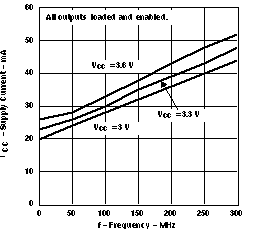 Figure 1. 'LVDS391 Supply Current vs (RMS) Switching Frequency
Figure 1. 'LVDS391 Supply Current vs (RMS) Switching Frequency
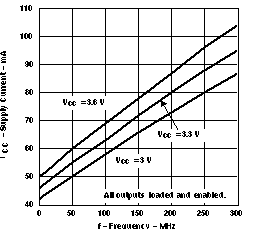 Figure 3. 'LVDS389 Supply Current (RMS) vs Switching Frequency
Figure 3. 'LVDS389 Supply Current (RMS) vs Switching Frequency
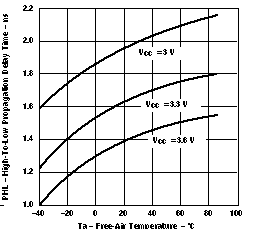 Figure 5. High-to-Low Propagation Delay Time vs Free-Air Temperature
Figure 5. High-to-Low Propagation Delay Time vs Free-Air Temperature
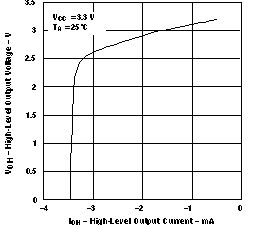 Figure 7. High-Level Output Voltage vs High-Level Output Current
Figure 7. High-Level Output Voltage vs High-Level Output Current
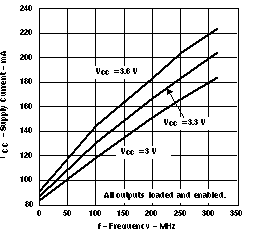 Figure 2. 'LVDS387 Supply Current (RMS) vs Switching Frequency
Figure 2. 'LVDS387 Supply Current (RMS) vs Switching Frequency
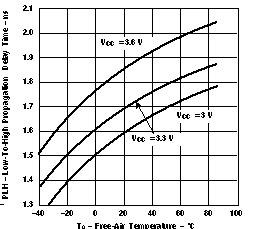 Figure 4. Low-to-High Propagation Delay Time vs Free-Air Temperature
Figure 4. Low-to-High Propagation Delay Time vs Free-Air Temperature
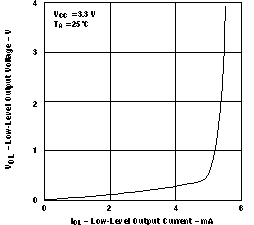 Figure 6. Low-Level Output Voltage vs Low-Level Output Current
Figure 6. Low-Level Output Voltage vs Low-Level Output Current
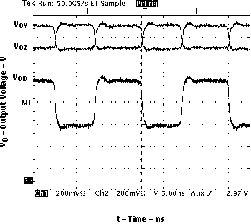 Figure 8. Output Voltage vs Time
Figure 8. Output Voltage vs Time